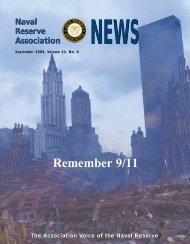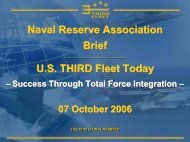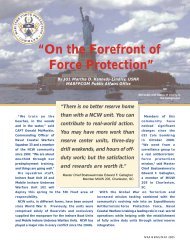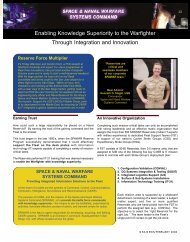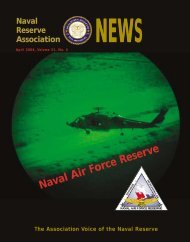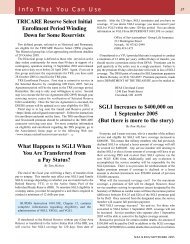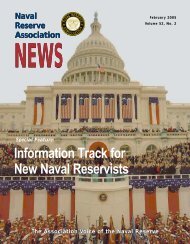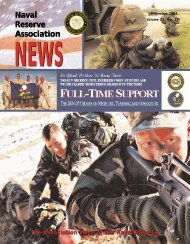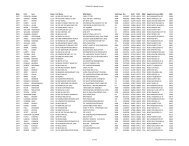Naval Reserve Association
Naval Reserve Association
Naval Reserve Association
- No tags were found...
Create successful ePaper yourself
Turn your PDF publications into a flip-book with our unique Google optimized e-Paper software.
S E A S C A P EThe seascape surrounding the Navy <strong>Reserve</strong> is, I believe, a bitmore clear than when I wrote a year ago. The PIM (plan ofintended movement for the aviators) is firming up. Is the Navy<strong>Reserve</strong> in shoal waters? No, but we are certainly sailing intouncharted waters! There are two central issues: Is an operational<strong>Reserve</strong>, without strategic warfighting capability, the right Navy<strong>Reserve</strong> for the country over the long haul? Can we sustain theoperational <strong>Reserve</strong> as it is being used today? I do not believe thatthere is anyone in Washington, DC, today who can answer thosequestions. That being the case, the nation is assuming risk.First the PIM. It is clear that we are moving to a Navy <strong>Reserve</strong>without its own hardware. The signs are everywhere from theNavy budget to VADM Cotton’s Navy <strong>Reserve</strong> Strategic Plan 8 tothe units that have disappeared one by one. And, I believe, therewill be others that willdisappear as a resultof this year’s POMsubmission. Five C-40aircraft have movedfrom the funded list to ahigh priority unfundedrequirement. Nowherewill you find discussionabout retaining, increasing,or building warfightingcapability in the <strong>Reserve</strong>Component. AdmiralCotton is very clear thatthere are no longer Navy<strong>Reserve</strong> requirements,only Navy requirem e n t s .Equipment, from ships,to aircraft, to small boats,to bulldozers is absentC-40from the discussion. VADM Cotton has told me personally, onseveral occasions, that the Navy cannot, in general, afford tohave equipment in the <strong>Reserve</strong> and that certainly seems to bethe course that we are on. In this regard, the Navy is on adifferent PIM from the other five DoD <strong>Reserve</strong> Components. Itis perhaps fair to add that the Air Force <strong>Reserve</strong> and MarineCorps <strong>Reserve</strong> are on a course more parallel to ours thandivergent. But, let’s be absolutely clear, the Navy is cutting Navy<strong>Reserve</strong> hardware units to save money, money to be spent for newNavy acquisitions.The other side of this coin is that no other <strong>Reserve</strong> Componentis as integrated as ours is today. That is an achievement worthy ofnote, and many of our Reservists are already benefiting from thatintegration. Reread our article last month on the Horn ofAfrica JTF and see how pleased our Reservists are with theirrole there. This is a big deal, and I don’t want to gloss over it.It isn’t a perfect story; and there are still cultural battles to befought, unfortunately, from the low end of the chain of commandall the way to the E-ring of the Pentagon. One cannot argue,however, that integration, where veteran Sailors add theirThe Navy <strong>Reserve</strong>expertise on a regular basis to the Active Component and arethemselves kept up to date, is a bad thing. The problem is notthe vision but the execution. The transition from “take thisswab and clean that deck, because I don’t have anything elsefor you to do” to “can you teach me how this is done in thecivilian world,” is a long one. Such change is also absolutelydependent upon our ability to fund transportation forReservists from home to the Active Component site. This ismoving forward, but it isn’t fixed.Another aspect of the PIM is that we are moving away fromwarfighting to combat support. We are moving from tooth totail. This is obviously an outgrowth of the lack of enthusiasmfor equipment in the <strong>Reserve</strong>, but is it something more? Is it amindset which says that it is easy for “civilian” medical,law enforcement, andbusiness types tobe effective militarymedical, MAAs, andintelligence specialists,but not so easy toretain combat skills?I sense that there isan undercurrent thatbelieves this and,while I think that it iswrong, I understandthe appeal of thatargument. The majorappeal is, of course,financial. But, doesit spring from aparochialism whichsays leave the toughstuff to the full-timeprofessionals? I’m afraid that it does, but that is strictlyopinion.The one aspect of the PIM which is still a bit murky is Navy<strong>Reserve</strong> authorized end-strength. You probably have seen thatwith this budget submission, the Navy <strong>Reserve</strong> is coming downanother three thousand or so to 67,800. About half of the cutscome from decommissioning squadrons and the remainder largelyfrom cutting unfilled billets according to VADM Cotton. 9 AfterFY-08, the number is to stabilize at 68,000. If you understand theFuture Years Defense Plan (FYDP), anything after the currentyear is subject to change and frequently does. Cutting unfilledbillets makes sense on the surface. Why continue to authorizeend-strength that isn’t filled. Unfortunately, we have always hada very fluid billet file so there are always unfilled billets in onearea and folks IAP in another area. More importantly, when youdon’t make your recruiting numbers, you will have unfilledbillets! (See page 19) If you don’t make your numbers again,you will have empty billets again. One can see where this spiralcould lead if recruiting, which is now a Navy responsibility nota Navy <strong>Reserve</strong> responsibility, isn’t fixed.18 NRA NEWS/APRIL 2007



